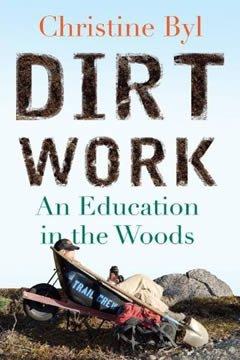Dirt Work: An Education in the Woods

Christine Byl grew up splashing in the lake, getting dirty and trying to avoid wearing a dress. A few decades later, it’s not hard for her to see how she ended up where she did: “It’s a great fit for me; it’s the person I always was as a kid.”
Where she has spent most of the last 16 years is on trails, working for the National Park Service in Montana and Alaska. (And, most recently, running a small trail design and construction business.) It started as a summer diversion when she was 22 years old. And then, over the years, the park became her home; the trail crew, family.
Her book, Dirt Work, is not so much the story of those years, but more of a glimpse into the subculture that exists behind the scenes in the National Park Service (NPS). “Most people recognize the seasonal NPS poster children, rangers in flat hats giving campfire talks, but few see behind the curtain, where mechanics keep the fleet running and maintenance guys empty rest-stop outhouses,” she wrote in the book’s introduction. “Carpenters, firefighters. The road crew, repainting traffic stripes, steaming ice out of culverts. And the traildogs.”
A “traildog” herself, Byl has spent almost every early spring to late fall clearing trails from fallen logs, building rock steps up mountain passes, clearing rocks from drainage ditches, building bridges, sinking signposts and blasting snowdrifts. In her book, she shares anecdotes of her experiences, from learning to swing an ax to leading a crew via zip line.
Along the way she learned from her co-workers, from the tools she used and about herself. She shares this in the book: “I was not born to labor, not led to it by heritage or expectation. In the age-old dichotomy made too much of, I was headed away from physical work, toward the education meant to save me from it. … It turns out, reality is more interwoven—more interesting—than dichotomies allow; it turns out I had a lot to learn.”
Byl, who has an MFA in fiction, said she never intended to write the book. “I’m always writing fiction, but I didn’t really ‘decide’ to write this book,” she said. “It was kind of a surprise to me; once a book is at the door of my mind, I can’t write anything else.”
And rather than autobiographical, Byl sees it as viewing a subculture using herself as the lens. “There’s not much written about this particular subculture,” she said. “It was fun to write about something about which a million things haven’t already been said.”
The book is an authentic look at the traildog subculture, including its language, habits and tools. “I don’t have the same filters some people do. When you write a book about this world that’s how you talk about it,” she said, referring to some crass language and bawdy anecdotes in the book. “Some people won’t want to read it; some will like it in spite of these references, and some will just like it.”
While Byl didn’t write the book for an intentional audience, she believes people with a passion for wilderness or labor, as well as people who are interested in subcultures, will find the book appealing. “I hope it interests anyone curious about the wide range of human experience,” she said. “As a reader, I am most drawn to books that fuse language and attention into an experience that opens me in a new way. As a writer, I can only hope my book does that for someone.”






